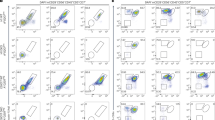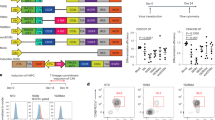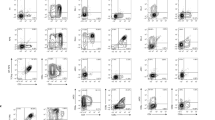Abstract
Avoiding the immune rejection of transplanted T cells is central to the success of allogeneic cancer immunotherapies. One solution to protecting T-cell grafts from immune rejection involves the deletion of allogeneic factors and of factors that activate cytotoxic immune cells. Here we report the generation of hypoimmunogenic cancer-antigen-specific T cells derived from induced pluripotent stem cells (iPSCs) lacking β2-microglobulin, the class-II major histocompatibility complex (MHC) transactivator and the natural killer (NK) cell-ligand poliovirus receptor CD155, and expressing single-chain MHC class-I antigen E. In mouse models of CD20-expressing leukaemia or lymphoma, differentiated T cells expressing a CD20 chimeric antigen receptor largely escaped recognition by NKG2A+ and DNAM-1+ NK cells and by CD8 and CD4 T cells in the allogeneic recipients while maintaining anti-tumour potency. Hypoimmunogenic iPSC-derived T cells may contribute to the creation of off-the-shelf T cell immunotherapies.
This is a preview of subscription content, access via your institution
Access options
Access Nature and 54 other Nature Portfolio journals
Get Nature+, our best-value online-access subscription
$29.99 / 30 days
cancel any time
Subscribe to this journal
Receive 12 digital issues and online access to articles
$99.00 per year
only $8.25 per issue
Buy this article
- Purchase on Springer Link
- Instant access to full article PDF
Prices may be subject to local taxes which are calculated during checkout






Similar content being viewed by others
Data availability
The main data supporting the results in this study are available within the paper and its Supplementary Information. The raw and analysed datasets generated during the study are too large to be publicly shared, but they are available for research purposes from the corresponding author on reasonable request.
References
Hammerl, D., Rieder, D., Martens, J. W. M., Trajanoski, Z. & Debets, R. Adoptive T cell therapy: new avenues leading to safe targets and powerful allies. Trends Immunol. 39, 921–936 (2018).
Rapoport, A. P. et al. NY-ESO-1-specific TCR-engineered T cells mediate sustained antigen-specific antitumor effects in myeloma. Nat. Med. 21, 914–921 (2015).
Kalos, M. et al. T cells with chimeric antigen receptors have potent antitumor effects and can establish memory in patients with advanced leukemia. Sci. Transl. Med. 3, 95ra73 (2011).
Qasim, W. et al. Molecular remission of infant B-ALL after infusion of universal TALEN gene-edited CAR T cells. Sci. Transl. Med. 9, eaaj2013 (2017).
Georgiadis, C. et al. Long terminal repeat CRISPR-CAR-coupled “universal” T cells mediate potent anti-leukemic effects. Mol. Ther. 26, 1215–1227 (2018).
Ren, J. et al. Multiplex genome editing to generate universal CAR T cells resistant to PD1 inhibition. Clin. Cancer Res. 23, 2255–2266 (2017).
Choi, B. D. et al. CRISPR–Cas9 disruption of PD-1 enhances activity of universal EGFRvIII CAR T cells in a preclinical model of human glioblastoma. J. Immunother. Cancer 7, 304 (2019).
Cornelissen, J. J. et al. Early CD4+ T-cell effector alloreactivity towards multiple mismatched HLA class II alleles is associated with graft predominance after double umbilical cord blood transplantation (DUCBT). Blood 126, 387 (2015).
Nianias, A. et al. Induced pluripotent stem cell (iPSC)-derived lymphocytes for adoptive cell immunotherapy: recent advances and challenges. Curr. Hematol. Malig. Rep. 14, 261–268 (2019).
Nishimura, T. et al. Generation of rejuvenated antigen-specific T cells by reprogramming to pluripotency and redifferentiation. Cell Stem Cell 12, 114–126 (2013).
Vizcardo, R. et al. Regeneration of human tumor antigen-specific T cells from iPSCs derived from mature CD8+ T cells. Cell Stem Cell 12, 31–36 (2013).
Kitayama, S. et al. Cellular adjuvant properties, direct cytotoxicity of re-differentiated Vα24 invariant NKT-like cells from human induced pluripotent stem cells. Stem Cell Rep. 6, 213–227 (2016).
Ueda, N. et al. Generation of TCR-expressing innate lymphoid-like helper cells that induce cytotoxic T cell-mediated anti-leukemic cell response. Stem Cell Rep. 10, 1935–1946 (2018).
Ando, M. et al. A safeguard system for induced pluripotent stem cell-derived rejuvenated T cell therapy. Stem Cell Rep. 5, 597–608 (2015).
Minagawa, A. et al. Enhancing T cell receptor stability in rejuvenated iPSC-derived T cells improves their use in cancer immunotherapy. Cell Stem Cell 23, 850–858.e4 (2018).
Themeli, M. et al. Generation of tumor-targeted human T lymphocytes from induced pluripotent stem cells for cancer therapy. Nat. Biotechnol. 31, 928–933 (2013).
Torikai, H. et al. Toward eliminating HLA class I expression to generate universal cells from allogeneic donors. Blood 122, 1341–1349 (2013).
Chen, H. et al. Functional disruption of human leukocyte antigen II in human embryonic stem cell. Biol. Res. 48, 59 (2015).
Rong, Z. et al. An effective approach to prevent immune rejection of human ESC-derived allografts. Cell Stem Cell 14, 121–130 (2014).
Gornalusse, G. G. et al. HLA-E-expressing pluripotent stem cells escape allogeneic responses and lysis by NK cells. Nat. Biotechnol. 35, 765–772 (2017).
Mattapally, S. et al. Human leukocyte antigen class I and II knockout human induced pluripotent stem cell-derived cells: universal donor for cell therapy. J. Am. Heart Assoc. 7, e010239 (2018).
Han, X. et al. Generation of hypoimmunogenic human pluripotent stem cells. Proc. Natl Acad. Sci. USA 116, 10441–10446 (2019).
Marino, J., Paster, J. & Benichou, G. Allorecognition by T lymphocytes and allograft rejection. Front. Immunol. 7, 582 (2016).
Gussow, D., Rein, R., Kottman, A. & Ploegh, H. L. The human β2-microglobulin gene. Primary structure and definition of the transcriptional unit. J. Immunol. 139, 3132–3138 (2016).
Holling, T. M., Schooten, E. & Van Den Elsen, P. J. Function and regulation of MHC class II molecules in T-lymphocytes: of mice and men. Hum. Immunol. 65, 282–290 (2004).
Salgado, F. J. et al. Interleukin-dependent modulation of HLA-DR expression on CD4 and CD8 activated T cells. Immunol. Cell Biol. 80, 138–147 (2002).
Lanier, L. L. NK cell recognition. Annu. Rev. Immunol. 23, 225–274 (2005).
King, A. et al. HLA-E is expressed on trophoblast and interacts with CD94/NKG2 receptors on decidual NK cells. Eur. J. Immunol. 30, 1623–1631 (2000).
Marín, R. et al. Analysis of HLA-E expression in human tumors. Immunogenetics 54, 767–775 (2003).
Tomasec, P. et al. Surface expression of HLA-E, an inhibitor of natural killer cells, enhanced by human cytomegalovirus gpUL40. Science 287, 1031–1033 (2000).
A.T., B. et al. NK cells expressing inhibitory KIR for non-self-ligands remain tolerant in HLA-matched sibling stem cell transplantation. Blood 115, 2686–2694 (2010).
Crew, M. D., Cannon, M. J., Phanavanh, B. & Garcia-Borges, C. N. An HLA-E single chain trimer inhibits human NK cell reactivity towards porcine cells. Mol. Immunol. 42, 1205–1214 (2005).
Braud, V. M. et al. HLA-E binds to natural killer cell receptors CD94/NKG2A, B and C. Nature 391, 795–799 (1998).
Ardolino, M. et al. DNAM-1 ligand expression on Ag-stimulated T lymphocytes is mediated by ROS-dependent activation of DNA-damage response: relevance for NK-T cell interaction. Blood 117, 4778–4786 (2011).
Cerboni, C. et al. Antigen-activated human T lymphocytes express cell-surface NKG2D ligands via an ATM/ATR-dependent mechanism and become susceptible to autologous NK-cell lysis. Blood 110, 606–615 (2007).
Tomasec, P. et al. Downregulation of natural killer cell-activating ligand CD155 by human cytomegalovirus UL141. Nat. Immunol. 6, 181–188 (2005).
Kruse, V. et al. Human induced pluripotent stem cells are targets for allogeneic and autologous natural killer (NK) cells and killing is partly mediated by the activating NK receptor DNAM-1. PLoS ONE 10, e0125544 (2015).
Yaguchi, T. et al. Human PBMC-transferred murine MHC class I/II-deficient NOG mice enable long-term evaluation of human immune responses. Cell. Mol. Immunol. 15, 953–962 (2018).
Ashizawa, T. et al. Antitumor effect of programmed death-1 (PD-1) blockade in humanized the NOG-MHC double knockout mouse. Clin. Cancer Res. 23, 149–158 (2017).
Sommermeyer, D. et al. Chimeric antigen receptor-modified T cells derived from defined CD8+ and CD4+ subsets confer superior antitumor reactivity in vivo. Leukemia 30, 492–500 (2015).
Deuse, T. et al. Hypoimmunogenic derivatives of induced pluripotent stem cells evade immune rejection in fully immunocompetent allogeneic recipients. Nat. Biotechnol. 37, 252–258 (2019).
Xu, H. et al. Targeted disruption of HLA genes via CRISPR–Cas9 generates iPSCs with enhanced immune compatibility. Cell Stem Cell 24, 566–578.e7 (2019).
Ren, J., Zhang, X., Liu, X., Fang, C. & Jiang, S. A versatile system for rapid multiplex genome-edited CAR T cell generation. Oncotarget 8, 17002–17011 (2017).
Merkle, F. T. et al. Human pluripotent stem cells recurrently acquire and expand dominant negative P53 mutations. Nature 545, 229–233 (2017).
Okita, K. et al. A more efficient method to generate integration-free human iPS cells. Nat. Methods 8, 409–412 (2011).
Lee, S. et al. Repurposing the cord blood bank for haplobanking of HLA-homozygous iPSCs and their usefulness to multiple populations. Stem Cells 36, 1552–1566 (2018).
Kaneko, S. & Yamanaka, S. To be immunogenic, or not to be: that’s the iPSC question. Cell Stem Cell 12, 385–386 (2013).
Taylor, C. J., Peacock, S., Chaudhry, A. N., Bradley, J. A. & Bolton, E. M. Generating an iPSC bank for HLA-matched tissue transplantation based on known donor and recipient HLA types. Cell Stem Cell 11, 147–152 (2012).
Ichise, H. et al. NK cell alloreactivity against KIR-ligand-mismatched HLA-haploidentical tissue derived from HLA haplotype-homozygous iPSCs. Stem Cell Rep. 9, 853–867 (2017).
Hashizume, O. et al. Epigenetic regulation of the nuclear-coded GCAT and SHMT2 genes confers human age-associated mitochondrial respiration defects. Sci. Rep. 5, 10434 (2015).
Wu, X., Zhang, Y., Li, Y. & Schmidt-wolf, I. G. H. Increase of antitumoral effects of cytokine-induced killer cells by antibody-mediated inhibition of MICA shedding. Cancers 12, 1818 (2020).
Chen, S., Zhou, Y., Chen, Y. & Gu, J. fastp: an ultra-fast all-in-one FASTQ preprocessor. Bioinformatics 17, 884–890 (2018).
Acknowledgements
We thank S. Yamanaka for providing the HLA-homozygous iPSC line and giving critical advice for our research work; H. Nakauchi for providing other iPSC lines; T. Nakahata for providing the animals; K. Eto, D. Suzuki and S. Nakamura for providing the B2M-knockout vector and giving critical advice for our research; P. Karagiannis for providing technical writing support for the manuscript; A. Tanaka for the animal care; M. Nomura for supporting the whole-exome sequencing analysis; P. Gee for supporting the gene modification using MaxCyte; Y. Mishima, Y. Kawai, N. Yanagawa and A. Maruyama for giving advice on our research work; and S. Kitayama, K. Ohara, Y. Miyake, E. Imai, A. Kumagai, S. Kamibayashi and K. Noda for technical assistance. This work was supported in part by Practical Research for Innovative Cancer Control, Core Center for iPS Cell Research from Japan Agency for Medical Research and Development (JP21bm0104001), and a Grant-in-Aid for Research Activity Start-up from the Japan Society for the Promotion of Science (19K23863).
Author information
Authors and Affiliations
Contributions
B.W. and S.K. designed the study; B.W. and S.K. interpreted the data; B.W., T.U., N.U., H.Y., T.I. and A.I. performed the experiments. R.I., M.G. and R.T. generated and provided the NOG dKO mice. B.W. and S.K. analysed the data; S.I., A.M., H.X., A.H., R.I., M.G. and R.T provided critical materials and advice for the experiments. S.I., M.W. and Y.U. contributed to the analysis and discussion of the data; S.K. supervised the study; and B.W. and S.K. wrote the manuscript.
Corresponding author
Ethics declarations
Competing interests
S.K. is a founder, shareholder and chief scientific officer at Thyas Co. Ltd and received research funding from Takeda Pharmaceutical Co. Ltd, Kirin Co. Ltd, Terumo Co. Ltd, Tosoh Co. Ltd and Thyas Co. Ltd.
Additional information
Peer review information Nature Biomedical Engineering thanks Cliona Rooney and the other, anonymous, reviewer(s) for their contribution to the peer review of this work. Peer reviewer reports are available.
Publisher’s note Springer Nature remains neutral with regard to jurisdictional claims in published maps and institutional affiliations.
Supplementary Information
Rights and permissions
About this article
Cite this article
Wang, B., Iriguchi, S., Waseda, M. et al. Generation of hypoimmunogenic T cells from genetically engineered allogeneic human induced pluripotent stem cells. Nat Biomed Eng 5, 429–440 (2021). https://doi.org/10.1038/s41551-021-00730-z
Received:
Accepted:
Published:
Issue Date:
DOI: https://doi.org/10.1038/s41551-021-00730-z
This article is cited by
-
Prediction of tumor-reactive T cell receptors from scRNA-seq data for personalized T cell therapy
Nature Biotechnology (2024)
-
Regeneration of joint surface defects by transplantation of allogeneic cartilage: application of iPS cell-derived cartilage and immunogenicity
Inflammation and Regeneration (2023)
-
HLA-based banking of induced pluripotent stem cells in Saudi Arabia
Stem Cell Research & Therapy (2023)
-
Cell-based passive immunization for protection against SARS-CoV-2 infection
Stem Cell Research & Therapy (2023)
-
Combining different CRISPR nucleases for simultaneous knock-in and base editing prevents translocations in multiplex-edited CAR T cells
Genome Biology (2023)



